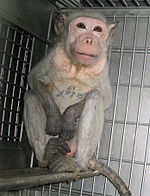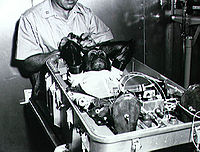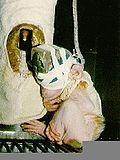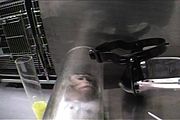- Animal testing on non-human primates
-
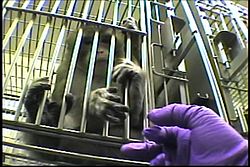 Image taken inside Covance
Image taken inside Covance
Experiments involving non-human primates (NHPs) include toxicity testing for medical and non-medical substances; studies of infectious disease, such as HIV and hepatitis; neurological studies; behavior and cognition; reproduction; genetics; and xenotransplantation. Around 65,000–70,000 are used every year in the United States and European Union. Most are purpose-bred, while some are caught in the wild.[1]
Their use is controversial. According to the Nuffield Council on Bioethics, NHPs are used because their brains share structural and functional features with human brains, but "[w]hile this similarity has scientific advantages, it poses some difficult ethical problems, because of an increased likelihood that primates experience pain and suffering in ways that are similar to humans."[2] Some of the most publicized attacks on animal research facilities by animal rights groups have occurred because of primate research. Some primate researchers have abandoned their studies because of threats or attacks.
In December 2006, an inquiry chaired by Sir David Weatherall, emeritus professor of medicine at Oxford University, concluded that there is a "strong scientific and moral case" for using primates in some research.[3] The British Union for the Abolition of Vivisection argues that the Weatherall report failed to address "the welfare needs and moral case for subjecting these sensitive, intelligent creatures to a lifetime of suffering in UK labs."[3]
Contents
Legal status
Human beings are recognized as persons and protected in law by the United Nations Universal Declaration of Human Rights[4] and by all governments to varying degrees. Non-human primates are not classified as persons, which largely means their individual interests have no formal recognition or protection. The status of non-human primates has generated much debate, particularly through the Great Ape Project (GAP), which argues that great apes (gorillas, orangutans, chimpanzees, bonobos) be given limited legal status and the protection of three basic interests: the right to live, the protection of individual liberty, and the prohibition of torture.[5]
On June 25, 2008, Spain became the first country to announce that it will extend rights to the great apes in accordance with GAP's proposals. An all-party parliamentary group advised the government to write legislation giving chimpanzees, bonobos, gorillas, and orangutans the right to life, to liberty, and the right not to be used in experiments. The New York Times reported that the legislation will make it illegal to kill apes, except in self-defense. "Torture," which will include medical experiments, will be not allowed, as will arbitrary imprisonment, such as for circuses or films.[6]
An increasing number of other governments are enacting bans.[7] As of 2006, Austria, New Zealand, the Netherlands, Sweden, and the UK had introduced either de jure or de facto bans.[8] The ban in Sweden does not extend to non-invasive behavioral studies, and graduate work on Great Ape cognition in Sweden continues to be carried out on zoo gorillas, and supplemented by studies of chimpanzees held in the U.S.[9] Sweden's legislation also bans invasive experiments on gibbons.
In December 2005, Austria outlawed experiments on any apes, unless it is conducted in the interests of the individual animal. In 2002, Belgium announced that it was working toward a ban on all primate use, and in the UK, 103 MPs signed an Early Day Motion calling for an end to primate experiments, arguing that they cause suffering and are unreliable.[8] No licenses have been issued in the UK since 1998.[10] The Boyd Group, a British group comprising animal researchers, philosophers, primatologists, and animal advocates, has recommended a global prohibition on the use of great apes.[11]
Species and numbers used
Most of the NHPs used are one of three species of macaques, accounting for 79% of all primates used in research in the UK, and 63% of all federally funded research grants for projects using primates in the U.S.[13] Lesser numbers of marmosets, tamarins, spider monkeys, owl monkeys, vervet monkeys, squirrel monkeys, and baboons are used in the UK and the U.S. Licenses approving the use of great apes, such as gorillas, chimpanzees, and orangutans, are not currently being issued in Britain, though their use has not been outlawed,[10] but chimpanzees are used in the U.S., with 1,133 in research laboratories as of October 2006.[13][14]
In the United States, nearly 55,000 NHPs were used in 2004,[15] an annual figure that has held steady since 1973, and 10,000 in the European Union in 2002.[16] Just over 4,000 were used in the UK in 2004. [17]
In 1996, the British Animal Procedures Committee recommended new measures for dealing with NHPs. The use of wild-caught primates was banned, except where "exceptional and specific justification can be established"; specific justification must be made for the use of old world primates (but not for the use of new world primates); approval for the acquisition of primates from overseas is conditional upon their breeding or supply center being acceptable to the Home Office; and each batch of primates acquired from overseas must be separately authorized.[18]
Prevalence
There are indications that NHP use is on the rise,[13] in part because biomedical research funds in the U.S. have more than doubled since the 1990s.[19] In 2000, the NIH published a report[20] recommending that the Regional Primate Research Center System be renamed the National Primate Research Center System and calling for an increase in the number of NHPs available to researchers, and stated that "nonhuman primates are crucial for certain types of biomedical and behavioral research." This assertion has been challenged.[21][22] In the U.S., the Oregon and California National Primate Research Centers and New Iberia Research Center have expanded their facilities.[23][24][25] In 2000 the National Institutes of Health (NIH) invited applications for the establishment of new breeding specific pathogen free colonies;[26] and a new breeding colony projected to house 3,000 NHPs has been set up in Florida.[27] The NIH's National Center for Research Resources claimed a need to increase the number of breeding colonies in its 2004–2008 strategic plan, as well as to set up a database, using information provided through a network of National Primate Research Centers, to allow researchers to locate NHPs with particular characteristics. [28] China is also increasing its NHP use, and is regarded as attractive to Western companies because of the low cost of research, the relatively lax regulations and the increase in animal-rights activism in the West.[13]
In 2005, British Home Office figures show that the number of primates used in the UK rose by 11 per cent in 2005 to 4,650 procedures, 440 more than in 2004.[29] In 2004, the government had reported a long-term downward trend in the use of new world primates (for example, marmosets, tamarins, squirrel, owl, spider and capuchin monkeys), but stated that the use of old world primates (for example, baboons and macaques) fluctuates and is more difficult to determine.[30] Crab-eating macaques and rhesus macaques are the most commonly used species in the UK.[31]
Sources
Further information: Laboratory animal sources, Nafovanny, Shamrock Farm, and International primate tradeThe American Society of Primatologists writes that most NHPs in laboratories in the United States are bred domestically. Between 12,000–15,000 are imported each year, specifically rhesus macaque monkeys, cynomolgus (crab-eating) macaque monkeys, squirrel monkeys, owl monkeys, and baboons. Monkeys are imported from the China, Mauritius, Israel, the Philippines, and Peru.[32][33]
China exported over 12,000 macaques for research in 2001 (4,500 to the U.S.), all from self-sustaining purpose-bred colonies.[34] The second largest source is Mauritius, from which 3,440 purpose-bred cynomolgous macaques were exported to the U.S. in 2001.[35]
In Europe, an estimated 70% of research primates are imported, and the rest are purpose-bred in Europe. Around 74% of these imports come from China, with most of the rest coming from Mauritius and Israel. [36]
Use
General
NHPs are used in research into HIV, neurology, behavior, cognition, reproduction, Parkinson's disease, stroke, malaria, respiratory viruses, infectious disease, genetics, xenotransplantation, drug abuse, and also in vaccine and drug testing. According to The Humane Society of the United States, chimpanzees are most often used in hepatitis research, and monkeys in SIV research. Animals used in hepatitis and SIV studies are often caged alone.[13]
Eighty-two percent of primate procedures in the UK in 2006 were in applied studies, which the Home Office defines as research conducted for the purpose of developing or testing commercial products.[37] Toxicology testing is the largest use, which includes legislatively required testing of drugs.[38] The second largest category of research using primates is "protection of man, animals, or environment", accounting for 8.9% of all procedures in 2006. The third largest category is "fundamental biological research,", accounting for 4.9% of all UK primate procedures in 2006. This includes neuroscientific study of the visual system, cognition, and diseases such as Parkinson's,[39] involving techniques such as inserting electrodes to record from or stimulate the brain, and temporary or permanent inactivation of areas of tissue.
Primates are the species most likely to be re-used in experiments. The Research Defence Society writes that re-use is allowed if the animals have been used in mild procedures with no lasting side-effects. [40] This is contradicted by Dr. Gill Langley of the British Union for the Abolition of Vivisection, who gives as an example of re-use the licence granted to Cambridge University to conduct brain experiments on marmosets. The protocol sheet stated that the animals would receive "multiple interventions as part of the whole lesion/graft repair procedure." Under the protocol, a marmoset could be given acute brain lesions under general anaesthetic, followed by tissue implantation under a second general anaesthetic, followed again central cannula implantation under a third. The re-use is allowable when required to meet scientific goals, such as this case in which some procedures are required as preparatory for others. [41]
Methods of restraint
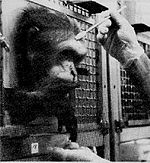 A primate trained to place his head and hands in holes in the front of his cage. The holes are placed in such a way as to allow the primate to reach for food while presenting his head for the experiment.[42]
A primate trained to place his head and hands in holes in the front of his cage. The holes are placed in such a way as to allow the primate to reach for food while presenting his head for the experiment.[42]
One of the disadvantages of using NHPs is that they can be difficult to handle, and various methods of physical restraint have to be used. Viktor Reinhardt of the Wisconsin Regional Primate Research Center writes that scientists may be unaware of the way in which their research animals are handled, and therefore fail to take into account the effect the handling may have had on the animals' health, and thereby on any data collected. Reinhardt writes that primatologists have long recognized that restraint methods may introduce an "uncontrolled methodological variable", by producing resistance and fear in the animal. "Numerous reports have been published demonstrating that non-human primates can readily be trained to cooperate rather than resist during common handling procedures such as capture, venipuncture, injection and veterinary examination. Cooperative animals fail to show behavioural and physiological signs of distress." [43]
Reinhardt lists common restraint methods as: squeeze-back cages, manual restraint, restraint boards, restraint chairs, restraint chutes, tethering, and nets.[43] Alternatives include:
- chemical restraint; for example, ketamine, a sedative, may be given to the animal before a restraint procedure, reducing stress-hormone production;
- psychological support, in which an animal under restraint has visual and auditory contact with the animal's cage-mate. Blood pressure and heart rate responses to restraint have been measurably reduced using psychological support.
- training animals to cooperate with restraint. Such methods have been used and resulted in unmeasurable stress hormone responses to venipuncture, and no notable distress to being captured in a transport box. [43]
Chimpanzees in the U.S.
There are around 1133 chimpanzees in research laboratories in the United States as of October 2006, and this number has been monotonically decreasing since the breeding ban of 1996.[14] Many have been used in hepatitis research, often caged alone because of the design of the research protocol. [44] Chimps routinely live 30 years in captivity, and can reach 60 years of age.[14]
Most of the labs either conduct or make the chimps available for invasive research,[45] defined as "inoculation with an infectious agent, surgery or biopsy conducted for the sake of research and not for the sake of the chimpanzee, and/or drug testing."[46] Two federally funded laboratories use chimps: Yerkes National Primate Research Center at Emory University in Atlanta, Georgia, and the Southwest National Primate Center in San Antonio, Texas.[47] Five hundred chimps have been retired from laboratory use in the U.S. and live in sanctuaries in the U.S. or Canada.[45]
Their importation from the wild was banned in 1973. From then until 1996, chimpanzees in U.S. facilities were bred domestically. Some others were transferred from the entertainment industry to animal testing facilities as recently as 1983, although it is not known if any animals that were transferred from the entertainment industry are still in testing centers.[48] Animal sanctuaries were not an option until the first North American sanctuary that would accept chimps opened in 1976.[49] In 1986, to prepare for research on AIDS, the U.S. bred them aggressively, with 315 breeding chimpanzees used to produce 400 offspring. By 1996, it was clear that SIV/HIV-2/SHIV in macaque monkeys was a preferred scientific AIDS model to the chimps, which meant there was a surplus. A five-year moratorium on breeding was therefore imposed by the U.S. National Institutes of Health (NIH) that year, and it has been extended annually since 2001. As of October 2006, the chimp population in US laboratories had declined to 1133 from a peak of 1500 in 1996. [14][47]
Chimpanzees tend to be used repeatedly over decades, rather than used and killed as with most laboratory animals. Some individual chimps currently in U.S. laboratories have been used in experiments for over 40 years.[50] The oldest known chimp in a U.S. lab is Wenka, who was born in a laboratory in Florida on May 21, 1954. She was removed from her mother on the day of birth to be used in a vision experiment that lasted 17 months, then sold as a pet to a family in North Carolina. She was returned to the Yerkes National Primate Research Center in 1957 when she became too big to handle. Since then, she has given birth six times, and has been used in research into alcohol use, oral contraceptives, aging, and cognitive studies.[51]
With the publication of the chimpanzee genome, there are reportedly plans to increase the use of chimps in labs, with scientists arguing that the federal moratorium on breeding chimps for research should be lifted.[47][52] Other researchers argue that chimps are unique animals and should either not be used in research, or should be treated differently. Pascal Gagneux, an evolutionary biologist and primate expert at the University of California, San Diego, argues that, given chimpanzees' sense of self, tool use, and genetic similarity to human beings, studies using chimps should follow the ethical guidelines that are used for human subjects unable to give consent.[47] Stuart Zola, director of the Yerkes National Primate Research Laboratory, disagrees. He told National Geographic: "I don't think we should make a distinction between our obligation to treat humanely any species, whether it's a rat or a monkey or a chimpanzee. No matter how much we may wish it, chimps are not human."[47]
A list of facilities holding chimpanzees and the numbers:[53][54]
- Alamogordo Primate Facility (affiliated with the National Institutes of Health and Charles River Laboratories) at Holloman Airforce base (245)
- M.D. Anderson Cancer Center, affiliated with the University of Texas (133)
- New Iberia Research Center, affiliated with the University of Louisiana (342)
- Primate Foundation of Arizona (a holding facility), affiliated with M.D. Anderson/University of Texas (73)
- Southwest National Primate Research Center, affiliated with the Southwest Foundation for Biomedical Research (236)
- Yerkes National Primate Research Center, affiliated with Emory University and Georgia State University (109 held); BIOQUAL, Inc. (15)
- Language Research Center, Georgia State University (4)
- Centers for Disease Control and Prevention (18)
- Food & Drug Administration (11 held) National Institutes of Health (11).
Notable studies
Polio
In the 1940s, Jonas Salk used Rhesus monkey cross-contamination studies to isolate the three forms of the polio virus that crippled hundreds of thousands of people yearly across the world at the time.[55] Salk's team created a vaccine against the strains of polio in cell cultures of Green monkey kidney cells. The vaccine was made publicly available in 1955, and reduced the incidence of polio 15-fold in the USA over the following five years. [56] Albert Sabin made a superior "live" vaccine by passing the polio virus through animal hosts, including monkeys. The vaccine was produced for mass consumption in 1963 and is still in use today. It had virtually eradicated polio in the USA by 1965.[57]
Split-brain experiments
In the 1950s, Roger Sperry developed split-brain preparations in non-human primates that emphasized the importance of information transfer that occurred in these neocortical connections. For example, learning on simple tasks, if restricted in sensory input and motor output to one hemisphere of a split-brain animal, would not transfer to the other hemisphere. The right brain has no idea what the left brain is up to, if these specific connections are cut. Those experiments were followed by tests on human beings with epilepsy who had undergone split-brain surgery, which established that the neocortical connections between hemispheres are the principal route for cognition to transfer from one side of the brain to another. These experiments also formed the modern basis for lateralization of function in the human brain.
Vision experiments
In the 1960s, David Hubel and Torsten Wiesel demonstrated the macrocolumnar organization of visual areas in cats and monkeys, and provided physiological evidence for the critical period for the development of disparity sensitivity in vision (i.e., the main cue for depth perception). They were awarded a Nobel Prize for their work.
Deep-brain stimulation
In 1983, designer drug users took MPTP, which created a Parkinsonian syndrome. Later that same year, researchers reproduced the effect in non-human primates. Over the next seven years, the brain areas that were over- and under-active in Parkinson's were mapped out in normal and MPTP-treated macaque monkeys using metabolic labelling and microelectrode studies. In 1990, deep brain lesions were shown to treat Parkinsonian symptoms in macaque monkeys treated with MPTP, and these were followed by pallidotomy operations in humans with similar efficacy. By 1993, it was shown that deep brain stimulation could effect the same treatment without causing a permanent lesion of the same magnitude. [58] Deep brain stimulation has largely replaced pallidotomy for treatment of Parkinson's patients that require neurosurgical intervention. Current estimates are that 20,000 Parkinson's patients have received this treatment.
AIDS
The non-human primate models of AIDS, using HIV-2, SHIV, and SIV in macaques, have been used as a complement to ongoing research efforts against the virus. The drug tenofovir has had its efficacy and toxicology evaluated in macaques, and found longterm-highdose treatments had adverse effects not found using shortterm-highdose treatment followed by longterm-lowdose treatment. This finding in macaques was translated into human dosing regimens. Prophylactic treatment with anti-virals has been evaluated in macaques, because introduction of the virus can only be controlled in an animal model. The finding that prophylaxis can be effective at blocking infection has altered the treatment for occupational exposures, such as needle exposures. Such exposures are now followed rapidly with anti-HIV drugs, and this practice has resulted in measurable transient virus infection similar to the NHP model. Similarly, the mother-to-fetus transmission, and its fetal prophylaxis with antivirals such as tenofovir and AZT, has been evaluated in controlled testing in macaques not possible in humans, and this knowledge has guided antiviral treatment in pregnant mothers with HIV. "The comparison and correlation of results obtained in monkey and human studies is leading to a growing validation and recognition of the relevance of the animal model. Although each animal model has its limitations, carefully designed drug studies in nonhuman primates can continue to advance our scientific knowledge and guide future clinical trials."[59][60][61]
Allegations
Many of the best-known allegations of abuse made by animal protection or animal rights groups against animal-testing facilities involve NHPs.
University of Wisconsin–Madison
Main article: Pit of despairThe so-called "pit of despair" was used in experiments conducted on rhesus macaque monkeys during the 1970s by American comparative psychologist Harry Harlow at the University of Wisconsin–Madison. [62] The aim of the research was to produce clinical depression. The vertical chamber was a stainless-steel bin with slippery sides that sloped to a rounded bottom. A 3/8 in. wire mesh floor 1 in. above the bottom of the chamber allowed waste material to drop out of holes. The chamber had a food box and a water-bottle holder, and was covered with a pyramid top so that the monkeys were unable to escape. [63]
Harlow placed baby monkeys in the chamber alone for up to six weeks. Within a few days, they stopped moving about and remained huddled in a corner. The monkeys generally exhibited marked social impairment and peer hostility when removed from the chamber; most did not recover.
University of California, Riverside
Main article: Britches (monkey)On April 21, 1985, activists of the Animal Liberation Front (ALF) broke into the UC Riverside laboratories and removed hundreds of animals. According to Vicky Miller of PETA, who reported the raid to newswire services, UC-Riverside "has been using animals in experiments on sight deprivation and isolation for the last two years and has recently received a grant, paid for with our tax dollars, to continue torturing and killing animals." According to UCR officials, the ALF claims of animal mistreatment were "absolutely false," and the raid would result in long-term damage to some of the research projects, including those aimed at developing devices and treatment for blindness. UCR officials also reported the raid also included smashing equipment and resulted in several hundred thousand dollars of damage.
Covance
Main article: CovanceIn Germany in 2004, journalist Friedrich Mülln took undercover footage of staff in Covance in Münster, Europe's largest primate-testing center. Staff were filmed handling monkeys roughly, screaming at them, and making them dance to blaring music. The monkeys were shown isolated in small wire cages with little or no natural light, no environmental enrichment, and subjected to high noise levels from staff shouting and playing the radio. [66] Primatologist Jane Goodall described their living conditions as "horrendous."
A veterinary toxicologist employed as a study director at Covance in Vienna, Virginia, from 2002 to 2004, told city officials in Chandler, Arizona, that Covance was dissecting monkeys while the animals were still alive and able to feel pain. The employee approached the city with her concerns when she learned that Covance planned to build a new laboratory in Chandler.[67]
She alleged that three monkeys in the Vienna laboratory had pushed themselves up on their elbows and had gasped for breath after their eyes had been removed, and while their intestines were being removed during necropsies (autopsy). When she expressed concern at the next study directors' meeting, she says she was told that it was just a reflex. She told city officials that she believed such movements were not reflexes but suggested "botched euthanasia performed by inadequately trained personnel."[67] She alleged that she was ridiculed and subjected to thinly veiled threats when she contacted her supervisors about the issue.
University of Cambridge
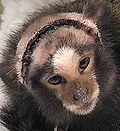 BUAV alleges that monkeys were left unattended for up to 15 hours after having parts of their brains removed to induce strokes.[68]
BUAV alleges that monkeys were left unattended for up to 15 hours after having parts of their brains removed to induce strokes.[68] Main article: Primate experiments at Cambridge University
Main article: Primate experiments at Cambridge UniversityIn the UK, after an undercover investigation in 1998, the British Union for the Abolition of Vivisection (BUAV), a lobby group, reported that researchers in Cambridge University's primate-testing labs were sawing the tops off marmosets' heads, inducing strokes, then leaving them overnight without veterinarian care, because staff worked only nine to five.[69] The experiments used marmosets that were first trained to perform certain behavioral and cognitive tasks, then re-tested after brain damage to determine how the damage had affected their skills. The monkeys were deprived of food and water to encourage them to perform the tasks, with water being withheld for 22 out of every 24 hours.[70][71]
The Research Defence Society defended Cambridge's research. The RDS wrote that the monkeys were fully anaesthetised, and appropriate pain killers were given after the surgery. "On recovery from the anaesthesia, the monkeys were kept in an incubator, offered food and water and monitored at regular intervals until the early evening. They were then allowed to sleep in the incubators until the next morning. No monkeys died unattended during the night after stroke surgery."[72] A court rejected BUAV's application for a judicial review. BUAV appealed.[73][74][dated info]
Columbia University
Main article: Primate experiments at Columbia UniversityIn 2003, CNN reported that a post-doctoral veterinarian at Columbia University complained to the university's Institutional Animal Care and Use Committee about experiments being conducted on baboons by E. Sander Connolly, an assistant professor of neurosurgery.[75] The experiment involved a left transorbital craniectomy to expose the left internal carotid artery to occlude the blood supply to the brain.[76] A clamp was placed on this blood vessel until the stroke was induced, after which Connolly would test a potential neuroprotective drug which if effective, would be used to treat humans suffering from stroke.[77] Connolly developed this methodology to make more consistent stroke infarcts in primates, which would improve the detection of differences in stroke treatment groups, and "provide important information not obtainable in rodent models." [78] The baboons were kept alive after the surgery for observation for three to ten days in a state of "profound disability" which would have been "terrifying," according to neurologist Robert Hoffman.[79] Connolly's published animal model states that animals were kept alive for three days, and that animals that were successfully self-caring were kept alive for 10 days.[76] People for the Ethical Treatment of Animals has expressed strong opposition to this experiment and has written multiple letters to the NIH and other federal agencies to halt further mistreatment of baboons and other animals at Columbia.[80][81]
An investigation by the U.S. Department of Agriculture found "no indication that the experiments...violated federal guidelines." The Dean of Research at Columbia's School of Medicine said that Connolly had stopped the experiments because of threats from animal rights activists, but still believed his work was humane and potentially valuable.
Attacks on researchers
In 2006, activists forced a primate researcher at UCLA to shut down the experiments in his lab. His name, phone number, and address were posted on the website of the UCLA Primate Freedom Project, along with a description of his research, which stated that he had "received a grant to kill 30 macaque monkeys for vision experiments. Each monkey is first paralyzed, then used for a single session that lasts up to 120 hours, and finally killed." [11] Demonstrations were held outside his home. A Molotov cocktail was placed on the porch of what was believed to be the home of another UCLA primate researcher. Instead, it was accidentally left on the porch of an elderly woman unrelated to the university. The Animal Liberation Front claimed responsibility for the attack. [82][83] As a result of the campaign, the researcher sent an email to the Primate Freedom Project stating "you win," and "please don’t bother my family anymore." [84] In another incident at UCLA in June 2007, the Animal Liberation Brigade placed a bomb under the car of a UCLA children's ophthalmologist, who performs experiments on cats and rhesus monkeys; the bomb had a faulty fuse and did not detonate.[85] UCLA is now refusing Freedom of Information Act requests for animal medical records.
The house of UCLA researcher Edythe London was intentionally flooded on October 20, 2007, in an attack claimed by the Animal Liberation Front. London conducts research on addiction using non-human primates, although no claims were made by the ALF of any violation of any rules or regulations regarding the use of animals in research. [86][87] London responded by writing an op-ed column in the LA Times titled "Why I use laboratory animals." [88]
In 2009, a UCLA neurobiologist had his car firebombed, for the second time. http://latimesblogs.latimes.com/lanow/2009/03/the-fbi-federal.html
See also
- International Primate Protection League
- National Primate Research Exhibition Hall
- Primate Freedom Project
Notes
- ^ "Animals used in research", U.S. Department of Agriculture, p. 10; "Primates, Basic facts", British Union for the Abolition of Vivisection
- ^ The ethics of research involving animals. Nuffield Council on Bioethics. 2005. http://www.nuffieldbioethics.org/go/browseablepublications/ethicsofresearchanimals/report_230.html. Retrieved 2008-07-16.
- ^ a b Morelle, Rebecca. "UK experts back primate research", BBC News, December 12, 2006.
- ^ UN Declaration of Human Rights
- ^ "Declaration on Great Apes", Great Ape Project.
- ^ McNeil, Donald G. When Human Rights Extend to Nonhumans, The New York Times, July 13, 2008; Roberts, Martin. Spanish parliament to extend rights to apes, Reuters, June 25, 2008; Glendinning, Lee. Spanish parliament approves 'human rights' for apes, The Guardian, June 26, 2008; Singer, Peter. Of great apes and men, The Guardian, July 18, 2008.
- ^ Guldberg, Helen. The great ape debate, Spiked online, March 29, 2001. Retrieved August 12, 2007.
- ^ a b Langley, Gill. Next of Kin: A Report on the Use of Primates in Experiments, British Union for the Abolition of Vivisection, p. 12.
- ^ Inside the Head of an Ape
- ^ a b "Testing on apes 'might be needed'", BBC News, June 3, 2006.
- ^ "The Boyd Group Papers on the use of Non-Human Primates in research and testing", The Boyd Group, British Psychological Society, 2002.
- ^ "Covance Cruelty", People for the Ethical Treatment of Animals.
- ^ a b c d e Conlee, Kathleen M; Hoffeld, Erika H; Stephens, Martin L (2004). "A Demographic Analysis of Primate Research in the United States". ATLA (Alternatives to Laboratory Animals) 32 (Sup 1): 315–322. http://www.worldcongress.net/2002/proceedings/C2%20Conlee.pdf.
- ^ a b c d Science article on chimps in the USA
- ^ 54,998 NHPs were used in 2004 in the United States, according to the U.S. Department of Agriculture's 2004 Animal Welfare Report, p. 10,
- ^ Langley, Gill. "Next of Kin: A Report on the Use of Primates in Experiments," British Union for the Abolition of Vivisection, June 2006, p. 38.
- ^ 4,208 NHPs were used in Britain in 2004 (Jha, Alok. "RSPCA outrage as experiments on animals rise to 2.85m", The Guardian, December 9, 2005)
- ^ "Statistics of Scientific Procedures on Living Animals", Great Britain, 2004, p. 87.
- ^ "Senate completes NIH doubling in 2003"
- ^ Full Scale Evaluation of the Regional Primate Research Centers Program—Final Report (Office of Science Policy and Public Liaison, National Center for Research Resources/NIH. 2000)
- ^ "Is Primate-Modeled Research Crucial? Pathways to Progress Autumn, 2003. Americans For Medical Advancement
- ^ "Background and References for Pathways to Progress, Autumn 2003."
- ^ "ONPRC Outdoor shelters"
- ^ "CNPRC expanding"
- ^ New 12,000 sq ft facility at New Iberia
- ^ "NIH RFA for new breeding colonies"
- ^ "Panther Tracts at Primate Products"
- ^ "2004–2008 Strategic Plan: Challenges and Critical Choices", National Center for Research Resources, National Institutes of Health.
- ^ Randerson, James. "Number of animal tests rises to 2.9m, highest total for 13 years, The Guardian, July 25, 2006.
- ^ "Statistics of Scientific Procedures on Living Animals", Great Britain, 2004, p. 16.
- ^ Langley, Gill. "Next of Kin: A Report on the Use of Primates in Experiments," British Union for the Abolition of Vivisection, June 2006, p. 31.
- ^ "Where do primates used for research purposes come from?", American Society of Primatologists.
- ^ International Perspectives: The Future of Nonhuman Primate Resources, Proceedings of the Workshop Held April 17–19
- ^ International Perspectives: The Future of Nonhuman Primate Resources, Proceedings of the Workshop Held April 17–19, pp. 197–200, page 149-56
- ^ International Perspectives: The Future of Nonhuman Primate Resources, Proceedings of the Workshop Held April 17–19, pp. 47–48
- ^ International Perspectives: The Future of Nonhuman Primate Resources, Proceedings of the Workshop Held April 17–19, pp. 63–68.
- ^ Home Office Statistics 2006
- ^ Langley, Gill. "Next of Kin: A Report on the Use of Primates in Experiments", British Union for the Abolition of Vivisection, June 2006, p.33-34.
- ^ Langley, Gill. "Next of Kin: A Report on the Use of Primates in Experiments", British Union for the Abolition of Vivisection, June 2006, p.37.
- ^ "Scientific study of primate research – call for evidence, Research Defence Society, March 24, 2005.
- ^ Langley, Gill. "Next of Kin: A Report on the Use of Primates in Experiments," British Union for the Abolition of Vivisection, June 2006, p. 32.
- ^ Reinhardt, Viktor and Cowley, Doug. Training Stumptailed Monkeys (Macaca arctoides) to Cooperate during In-Homecage Treatment, Laboratory Primate Newsletter, Volume 29, number 4, October 4, 1990.
- ^ a b c Reinhardt, V. et al. "Restraint methods of laboratory non-human primates: a critical review", Animal Welfare 1995, 4: 221–238.
- ^ "An Introduction to Primate Issues", The Humane Society of the United States. Retrieved July 13, 2006.
- ^ a b Chimpanzee lab and sanctuary map, Humane Society of the United States.
- ^ Chimpanzee Research: Overview of Research Uses and Costs, Humane Society of the United States.
- ^ a b c d e Lovgren, Stefan. Should Labs Treat Chimps More Like Humans?, National Geographic News, September 6, 2005.
- ^ See Sue Ellen (#440) and Billy Jo (#447)
- ^ Wildlife Waystation Fact Sheet
- ^ Chimps Deserve Better, Humane Society of the United States.
- ^ Wenka, Project R&R, New England Anti-Vivisection Society.
- ^ Langley, Gill. Next of Kin: A Report on the Use of Primates in Experiments, British Union for the Abolition of Vivisection, p. 15, citing VandeBerg, JL et al. "A unique biomedical resource at risk," Nature 437:30–32.
- ^ The Round-Up, Vol. 4, No. 1, 2005 Southwest National Primate Research Center
- ^ "Research Labs with Chimpanzees", Project R&R, New England Anti-Vivisection Society.
- ^ [www.post-gazette.com/pg/05093/481117.stm Virus-typing of polio by Salk].
- ^ Salk polio virus
- ^ History of polio vaccine
- ^ "The History of Deep Brain Simulation" (Overview of development of DBS in Parkinson's) at "The Parkinson's Appeal for Deep Brain Simulation."
- ^ AIDS Reviews 2005;7:67–83 Antiretroviral Drug Studies in Nonhuman Primates: a Valid Animal Model for Innovative Drug Efficacy and Pathogenesis Experiments
- ^ PMPA blocks SIV in monkeys
- ^ PMPA is tenofovir
- ^ Blum, Deborah. The Monkey Wars. Oxford University Press, 1994, p. 95.
- ^ Suomi, Stephen John. Experimental Production of Depressive Behavior in Young Rhesus Monkeys: A thesis submitted in partial fulfillment of the requirements for the degree of Doctor of Philosophy (Psychology) at the University of Wisconsin–Madison. University of Wisconsin–Madison, 1971, p. 33.
- ^ http://www.cjonline.org/animalsDissection2Britches.htm
- ^ http://www.covancecruelty.com/photos.asp
- ^ Undercover footage of staff in Covance screaming at and mocking monkeys, video.
- ^ a b "Former Study Director Reports Hideous, Systematic Cruelty at Covance; PETA Calls For Federal Investigation of Alleged Atrocities", People for the Ethical Treatment of Animals, November 28, 2006.
- ^ Laville, Sandra. "Lab monkeys 'scream with fear' in tests" The Guardian, February 8, 2005.
- ^ Laville, Sandra (February 8, 2005). "Lab monkeys 'scream with fear' in tests". The Guardian (London). http://www.guardian.co.uk/uk_news/story/0,3604,1407818,00.html.
- ^ http://www.buav.org/undercover/cambridge.html
- ^ http://www.buav.org/zerooption/video/lessi.mpg
- ^ http://www.rds-online.org.uk/pages/news.asp?i_ToolbarID=6&i_PageID=1816
- ^ http://scienceandresearch.homeoffice.gov.uk/animal-research/publications/publications/reports-and-reviews/chief_insp_animals_review.pdf?view=Standard&pubID=236685
- ^ http://www.bailii.org/cgi-bin/markup.cgi?doc=/ew/cases/EWHC/Admin/2005/530.html&query=buav&method=all
- ^ Sander Connolly [1]
- ^ a b "A Modified Transorbital Baboon Model of Reperfused Stroke" Huang (2000)[2]
- ^ "Collaboration may be the cure for what ails drug development" Erickson (2003)[3]
- ^ "A Modified Transorbital Baboon Model of Reperfused Stroke" Huang (2000)
- ^ Hoffman (2003)[4]
- ^ Letter to the Office of Laboratory Animal Welfare [5]
- ^ Letter to the USDA [6]
- ^ http://www.kxmb.com/getARticle.asp?ArticleId=36447
- ^ http://www.insidehighered.com/news/2006/08/22/animal
- ^ http://www.investors.com/editorial/editorialcontent.asp?secid=1501&status=article&id=241311597601024
- ^ [7] UCLA Monkey Madness
- ^ [8] Daily Bruin, UCLA Paper, on London incident
- ^ [9] ALF Communique on London incident
- ^ [10] Why I use Animals, LA Times Op-Ed by Dr. London
External links
- Primate Experimentation – Cruelty or 'Science'? : Save The Primates
- ReleaseChimps.org "Release and Restitution for Chimpanzees in US. laboratories", Project R&R.
- "Statistics of Scientific Procedures on Living Animals"PDF (1.19 MB), , UK 2004.
- Chimpanzees in Research: Past, Present, and Future from The State of the Animals III: 2005
Biomedical research: Clinical study design / Design of experiments Overview Controlled study
(EBM I to II-1; A to B)Observational study
(EBM II-2 to II-3; B to C)Epidemiology/
methodsoccurrence: Incidence (Cumulative incidence) · Prevalence (Point prevalence, Period prevalence)
association: absolute (Absolute risk reduction, Attributable risk, Attributable risk percent) · relative (Relative risk, Odds ratio, Hazard ratio)
other: Virulence · Infectivity · Mortality rate · Morbidity · Case fatality · Specificity and sensitivity · Likelihood-ratios · Pre/post-test probabilityTrial/test types In vitro / In vivo · Animal testing · Animal testing on non-human primates · First-in-man study · Multicenter trial · Seeding trial · Vaccine trial
Analysis of clinical trials Risk–benefit analysis
Interpretation of results Animal testing Main articles Animal testing · Alternatives to animal testing · Animal testing on invertebrates · Animal testing on frogs · Animal testing on non-human primates · Animal testing on rabbits · Animal testing on rodents · Animal testing regulations · History of animal testing · History of model organisms · Laboratory animal sources · Toxicology testing
Issues Animal rights · Animal welfare · Pain and suffering in laboratory animals · Biomedical research · Animals (Scientific Procedures) Act 1986 · Great Ape research ban · International trade in primatesControversial experiments Companies Charles River Laboratories, Inc. · Covance · Harlan · Huntingdon Life Sciences · Laboratory animal suppliers in the United Kingdom · Nafovanny · Shamrock FarmGroups/campaigns Americans for Medical Progress · American Association for Laboratory Animal Science · American Association for the Advancement of Science · Boyd Group · British Union for the Abolition of Vivisection · Dr Hadwen Trust · Foundation For Biomedical Research · National Anti-Vivisection Society · People for the Ethical Treatment of Animals (PETA) · ALF · Physicians Committee for Responsible Medicine · Primate Freedom Project · Pro-Test · SPEAK · Research Defence Society · SHAC · Stop Sequani Animal TestingWriters/activists Colin Blakemore · Carl Cohen · Gill Langley · Ingrid Newkirk · Neal Barnard · Jerry Vlasak · Simon Festing · Tipu AzizCategories Categories:
Wikimedia Foundation. 2010.

